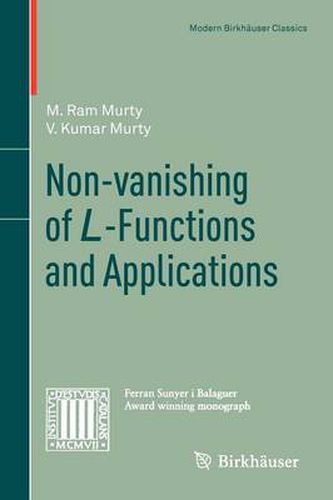Readings Newsletter
Become a Readings Member to make your shopping experience even easier.
Sign in or sign up for free!
You’re not far away from qualifying for FREE standard shipping within Australia
You’ve qualified for FREE standard shipping within Australia
The cart is loading…






This title is printed to order. This book may have been self-published. If so, we cannot guarantee the quality of the content. In the main most books will have gone through the editing process however some may not. We therefore suggest that you be aware of this before ordering this book. If in doubt check either the author or publisher’s details as we are unable to accept any returns unless they are faulty. Please contact us if you have any questions.
This monograph brings together a collection of results on the non-vanishing of- functions.Thepresentation,thoughbasedlargelyontheoriginalpapers,issuitable forindependentstudy.Anumberofexerciseshavealsobeenprovidedtoaidinthis endeavour. The exercises are of varying di?culty and those which require more e?ort have been marked with an asterisk. The authors would like to thank the Institut d'Estudis Catalans for their encouragementof thiswork throughtheFerranSunyeriBalaguerPrize.Wewould also like to thank the Institute for Advanced Study, Princeton for the excellent conditions which made this work possible, as well as NSERC, NSF and FCAR for funding. Princeton M. Ram Murty August, 1996 V. Kumar Murty xi Introduction Since the time of Dirichlet and Riemann, the analytic properties of L-functions have been used to establish theorems of a purely arithmetic nature. The dist- bution of prime numbers in arithmetic progressions is intimately connected with non-vanishing properties of various L-functions. With the subsequent advent of the Tauberian theory as developed by Wiener and Ikehara, these arithmetical t- orems have been shown to be equivalent to the non-vanishing of these L-functions on the line Re(s)=1. In the 1950’s, a new theme was introduced by Birch and Swinnerton-Dyer. Given an elliptic curve E over a number ?eld K of ?nite degree over Q,they associated an L-function to E and conjectured that this L-function extends to an entire function and has a zero at s = 1 of order equal to the Z-rank of the group of K-rational points of E. In particular, the L-function vanishes at s=1ifand only if E has in?nitely many K-rational points.
$9.00 standard shipping within Australia
FREE standard shipping within Australia for orders over $100.00
Express & International shipping calculated at checkout
This title is printed to order. This book may have been self-published. If so, we cannot guarantee the quality of the content. In the main most books will have gone through the editing process however some may not. We therefore suggest that you be aware of this before ordering this book. If in doubt check either the author or publisher’s details as we are unable to accept any returns unless they are faulty. Please contact us if you have any questions.
This monograph brings together a collection of results on the non-vanishing of- functions.Thepresentation,thoughbasedlargelyontheoriginalpapers,issuitable forindependentstudy.Anumberofexerciseshavealsobeenprovidedtoaidinthis endeavour. The exercises are of varying di?culty and those which require more e?ort have been marked with an asterisk. The authors would like to thank the Institut d'Estudis Catalans for their encouragementof thiswork throughtheFerranSunyeriBalaguerPrize.Wewould also like to thank the Institute for Advanced Study, Princeton for the excellent conditions which made this work possible, as well as NSERC, NSF and FCAR for funding. Princeton M. Ram Murty August, 1996 V. Kumar Murty xi Introduction Since the time of Dirichlet and Riemann, the analytic properties of L-functions have been used to establish theorems of a purely arithmetic nature. The dist- bution of prime numbers in arithmetic progressions is intimately connected with non-vanishing properties of various L-functions. With the subsequent advent of the Tauberian theory as developed by Wiener and Ikehara, these arithmetical t- orems have been shown to be equivalent to the non-vanishing of these L-functions on the line Re(s)=1. In the 1950’s, a new theme was introduced by Birch and Swinnerton-Dyer. Given an elliptic curve E over a number ?eld K of ?nite degree over Q,they associated an L-function to E and conjectured that this L-function extends to an entire function and has a zero at s = 1 of order equal to the Z-rank of the group of K-rational points of E. In particular, the L-function vanishes at s=1ifand only if E has in?nitely many K-rational points.